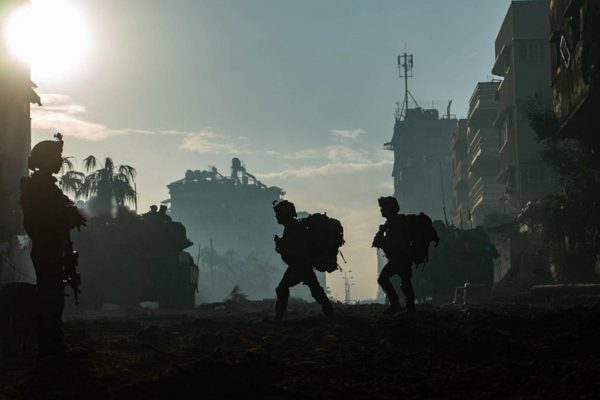The report’s findings are based on primary-source research and extensive discussions with senior Israeli officials during a fact-finding visit to the country.
By Yaakov Lappin, JNS
According to a newly published report authored by U.S. military legal experts and former commanders, the Israel Defense Forces has conducted its war against Hamas in Gaza “effectively and legally.”
The authors of the report, published on Thursday by the Jewish Institute for National Security of America (JINSA), include Gen. (ret.) David Rodriguez, former head of U.S. Africa Command; Adm. (ret.) Michael Rogers, former commander of the U.S. Navy; and Gen. (ret.) Charles Wald, former deputy commander of U.S. European Command.
The report’s findings are based on primary-source research and extensive discussions with senior Israeli officials during a fact-finding visit to the country.
“Israel has faced a lot of criticism for its conduct of the war in Gaza and many of the questions being raised are ones of military strategy, operations, tactics and law,” said Rodriguez.
“I felt it was very important for U.S. policymakers and the American public, as they make up their minds about what is happening in Gaza, to hear the perspective of American military leaders who had fought in similar conflicts, faced similar adversaries, and grappled with some of the same questions of how to fight them,” he continued.
Israel’s efforts to eliminate the Hamas threat are grounded in its right and responsibility to restore security for its citizens, the report states.
“The barbaric October 7 attack was just one part of the multi-front threat that Israel faces from Iran and its proxies. In defending itself against this threat, Israel is justified in seeking to eliminate Hamas’s ability to ever attack it again,” said Wald.
“And the IDF has pursued that mission effectively and legally against an adversary that is doing everything it possibly can—including cynically putting its own civilians in the line of fire—to discredit and delegitimize Israel.”
Despite accusations to the contrary, the Israeli military has succeeded in navigating the complex environment while adhering to the Laws of Armed Conflict (LOAC), the authors state.
Hamas, by contrast, has repeatedly violated the LOAC by using civilians and civilian infrastructure as shields, according to the authors.
Hamas is described in the report as a “terror army” with the structure, training, and advanced weaponry of a conventional force. Its tactics include not wearing uniforms, attacking civilians and using civilian infrastructure for military purposes.
Hamas, the authors write, “Has intentionally and systemically” violating the laws of war “by dragging civilians into the fight, using them to shield their personnel and assets in an attempt to compel the IDF to inflict civilian casualties so as to trigger opposition to Israel by the United States, European countries, the United Nations, and international courts as well as in public opinion.”
The IDF, by contrast, goes out of its way to minimize civilian casualties.
“We … observed that the IDF took steps to mitigate the risk of civilian casualties in the conduct of hostilities and, on many occasions, we believe, prioritized mitigating civilian risk over anticipated tactical advantage or striking legitimate military targets,” the report states.
It also notes the IDF’s ability to integrate air power, indirect fire (artillery) and ground forces in maneuvers both above and below ground, and the level of support the Israeli Air Force is able to provide for ground units, both in terms of direct support and via intelligence-gathering.
“The IDF’s performance on Gaza’s complicated battlefield demonstrates operational and tactical excellence,” the authors state.
“The U.S. military would benefit from studying how the IDF fought effectively in this highly complex, multi-domain environment,” they add.
Based on available information, approximately 90% of the strikes carried out by the IDF in Gaza, even those carried out by drones, were pre planned, “although planning may have occurred only 10 minutes before the operation,” the authors state.
Only about 10% were dynamic, real-time strikes, most of which were launched by remotely-piloted drones carrying small, precision-guided munitions, they add.
“The IDF was able to assign the most appropriate available capability to deal with a threat and direct fire accurately,” the authors conclude.
The report notes that since Oct. 7, Israel has faced threats not only from Hamas but also from other Iranian-backed terror armies, as well as from Iran itself.
Employing Iranian doctrine, Hamas transformed Gaza into a fortified battleground and terror base, integrating civilian infrastructure into its military-terrorist assets to oppose Israeli advances and increase civilian casualties, said the former American military officials.
While the Israeli military has made “some improvements” compared to past conflicts in this regard, it faces “challenges communicating with international audiences, combatting Hamas disinformation, and conveying the gravity of the enemy threat,” the report states.
Better strategic communication is needed to convey the IDF’s objectives and actions clearly, as well as the severity of threat posed by a resurgent Hamas, the authors argue.
The report calls on the Israeli government to formulate a clearer day-after strategy for Gaza, arguing that “Israel could advance its strategic objectives more and help counteract negative public perceptions that Israel’s enemies only seek to amplify by going beyond what is legally mandated and taking responsibility for delivering aid and administering Gaza in the interregnum between Hamas and whatever comes next.”





